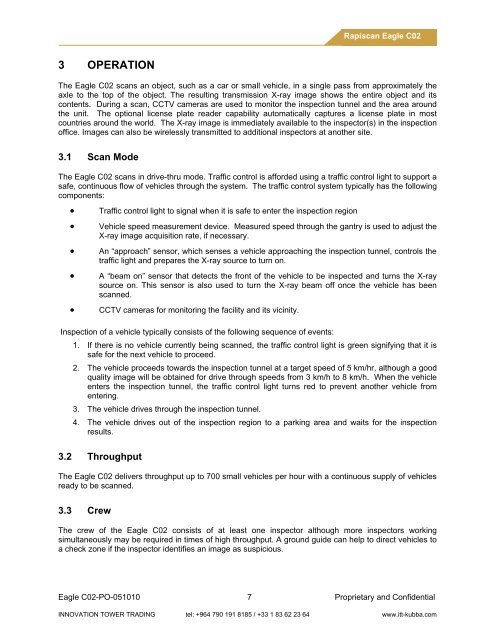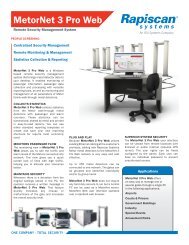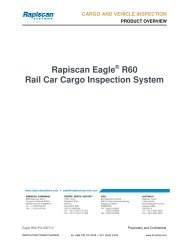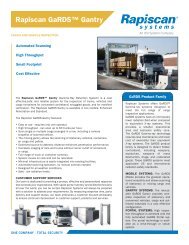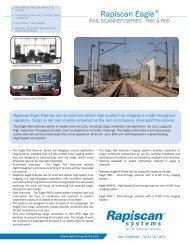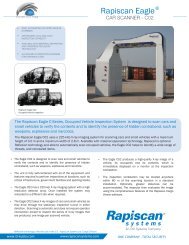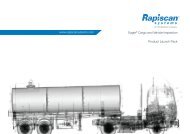Rapiscan Eagle C02 Occupied Vehicle Inspection System - ITT-Kubba
Rapiscan Eagle C02 Occupied Vehicle Inspection System - ITT-Kubba
Rapiscan Eagle C02 Occupied Vehicle Inspection System - ITT-Kubba
You also want an ePaper? Increase the reach of your titles
YUMPU automatically turns print PDFs into web optimized ePapers that Google loves.
3 OPERATION<br />
<strong>Rapiscan</strong> <strong>Eagle</strong> <strong>C02</strong><br />
The <strong>Eagle</strong> <strong>C02</strong> scans an object, such as a car or small vehicle, in a single pass from approximately the<br />
axle to the top of the object. The resulting transmission X-ray image shows the entire object and its<br />
contents. During a scan, CCTV cameras are used to monitor the inspection tunnel and the area around<br />
the unit. The optional license plate reader capability automatically captures a license plate in most<br />
countries around the world. The X-ray image is immediately available to the inspector(s) in the inspection<br />
office. Images can also be wirelessly transmitted to additional inspectors at another site.<br />
3.1 Scan Mode<br />
The <strong>Eagle</strong> <strong>C02</strong> scans in drive-thru mode. Traffic control is afforded using a traffic control light to support a<br />
safe, continuous flow of vehicles through the system. The traffic control system typically has the following<br />
components:<br />
� Traffic control light to signal when it is safe to enter the inspection region<br />
� <strong>Vehicle</strong> speed measurement device. Measured speed through the gantry is used to adjust the<br />
X-ray image acquisition rate, if necessary.<br />
� An “approach” sensor, which senses a vehicle approaching the inspection tunnel, controls the<br />
traffic light and prepares the X-ray source to turn on.<br />
� A “beam on” sensor that detects the front of the vehicle to be inspected and turns the X-ray<br />
source on. This sensor is also used to turn the X-ray beam off once the vehicle has been<br />
scanned.<br />
� CCTV cameras for monitoring the facility and its vicinity.<br />
<strong>Inspection</strong> of a vehicle typically consists of the following sequence of events:<br />
1. If there is no vehicle currently being scanned, the traffic control light is green signifying that it is<br />
safe for the next vehicle to proceed.<br />
2. The vehicle proceeds towards the inspection tunnel at a target speed of 5 km/hr, although a good<br />
quality image will be obtained for drive through speeds from 3 km/h to 8 km/h. When the vehicle<br />
enters the inspection tunnel, the traffic control light turns red to prevent another vehicle from<br />
entering.<br />
3. The vehicle drives through the inspection tunnel.<br />
4. The vehicle drives out of the inspection region to a parking area and waits for the inspection<br />
results.<br />
3.2 Throughput<br />
The <strong>Eagle</strong> <strong>C02</strong> delivers throughput up to 700 small vehicles per hour with a continuous supply of vehicles<br />
ready to be scanned.<br />
3.3 Crew<br />
The crew of the <strong>Eagle</strong> <strong>C02</strong> consists of at least one inspector although more inspectors working<br />
simultaneously may be required in times of high throughput. A ground guide can help to direct vehicles to<br />
a check zone if the inspector identifies an image as suspicious.<br />
<strong>Eagle</strong> <strong>C02</strong>-PO-051010 7 Proprietary and Confidential<br />
INNOVATION TOWER TRADING tel: +964 790 191 8185 / +33 1 83 62 23 64 www.itt-kubba.com


